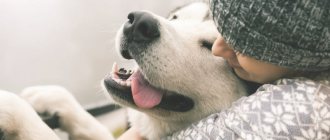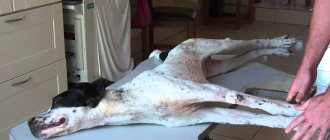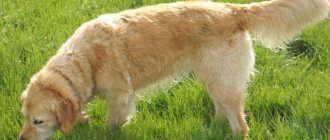Dog rabies photo
Rabies is a very dangerous and fatal disease in dogs . The animal becomes infected with a virus that causes acute attacks and damages the nervous system. As a result, the dog may be afraid of water, nervousness appears, and soon muscle paralysis, suffocation and death occur. That is why it is important to recognize the disease in time.
Content
1. Rabies - definition 2. Possible routes of infection 3. Features of the incubation period 4. Symptoms and signs indicating that a dog is infected with rabies 5. How can rabies be detected in an animal 6. Is it possible to cure rabies 7. Basic preventive measures, organization of treatment 8. Correct solution 9. Video
Rabies in dogs is a dangerous viral disease that is practically untreatable and, after the appearance of characteristic symptoms, almost always ends in death. The deadly virus is transmitted through a bite or close contact between animals, and people are also at risk.
The dog owner should know all the main symptoms of rabies in the dog, as well as the procedure to follow if any suspicion arises. Delay in this case is unacceptable, since not just the health of the animal is at stake, but also its very life. In addition, any dog owner should be able to take first aid measures for people bitten by an infected dog. Whether a person gets sick directly depends on correct and timely exposure!
Immunity
- Only cold-blooded animals have natural immunity to rabies.
- Vaccinal immunity is based on the production of antibodies to the viruses that cause the disease.
- According to many researchers, not only humoral immunity (production of antibodies) plays an important role in rabies, but also tissue immunity and the production of virus inhibitors - interferons - by the vaccinated body.
Passive immunization with rabies gamma globulin is the most effective method of treating and preventing rabies.
Rabies - definition
Rabies in dogs is a viral infectious disease that occurs in an extremely severe form and is characterized by progressive damage to the brain, spinal cord, central nervous system and, in the vast majority of cases, leads to death. It is possible to counteract a deadly virus only if the very first symptoms of the disease are identified in a timely manner and all necessary countermeasures are taken.
The most important responsibility of every dog owner is to know and be able to distinguish the slightest signs of a viral disease.
There are the following main types of virus:
| Street (Wild) | It is he who poses the greatest danger, circulating and being transmitted from one individual to another in the natural habitat of animals (primarily dogs). |
| Fixed | It does not cause disease and is used by doctors to develop and obtain an antidote - special vaccines. |
The virus multiplies first in the cells of the medulla oblongata, then spreads to the lumbar back and affects the entire central nervous system of the dog. The causative agent is a specific RNA; it can spread everywhere, maintaining its activity and danger at low temperatures, as well as under the influence of a number of chemically active substances and drugs.
What can definitely destroy the virus is high temperatures; the resistance of hydrophobia is sharply lost under the influence of direct sunlight.
Possible routes of infection
Almost every dog can get rabies, regardless of age, breed, or good health.
At risk are:
- Unvaccinated dogs.
- Small puppies whose immune systems have not yet developed.
- Exhausted creatures weakened by other diseases;
- Individuals living in areas where unfavorable conditions have been recorded precisely due to the widespread spread of the rabies virus.
- Animals living in close proximity to forests and capable of contact with wild animals.
There is an increased risk of “catching” a deadly disease in hunting dogs, including those who take part in hunting foxes, hares, animals living in minks, etc.
As a rule, the rabies virus enters the dog’s body along with the saliva of a sick animal that is a carrier of the disease. Most often, when a healthy dog is bitten by a sick individual.
IMPORTANT!: A rabid dog becomes contagious immediately after it itself has been infected with the virus. It remains extremely dangerous at any of the other stages of disease progression.
During the incubation period, only experienced specialists and attentive owners who take responsibility for the health of their pet are able to clearly identify the problem and organize measures to counter the spread of the disease and cure the infected dog. Infection with rabies can also occur if the saliva of a sick animal gets into a wound, a deep crack in the skin, or onto the mucous membrane of internal organs.
If a pet has not been vaccinated in a timely manner or has not been vaccinated against rabies, it automatically falls into a high-risk group. If infected, such a dog has practically no chance of survival; death is guaranteed. Therefore, you should not wait for the manifestation of any symptoms; the recommendations of experts are clear: it is necessary to carry out periodic vaccination in accordance with the established timing and frequency.
Dog owners should be aware of the fact that the incubation period for rabies occurs with virtually no symptoms, and at the end of it there is a sharp activation of the virus, its accumulation in saliva (one of the reasons for increased salivation) and a sharp manifestation of all the main adverse signs of damage to the nervous system, musculoskeletal system. the animal's locomotor system.
Consequences of a positive result
If, after research, rabies is confirmed, the animal must be euthanized, since there is simply no treatment. The main way to keep your dog safe is to get a vaccine, otherwise this virus will become fatal to it and also dangerous to everyone who comes into contact with the animal. After the latent period ends and symptoms appear, the pet’s life will last another 10-12 days. However, a dog is dangerous before symptoms appear, so a vaccine is the most sensible and safe method.
Features of the incubation period
A distinctive feature of the onset of the disease is the almost complete absence of any obvious or indirect signs and symptoms. A natural focal infection of the viral type, having entered the animal’s body, is in no hurry to show itself and gradually “accumulates strength.”
The incubation period for this infection does not have a clearly limited time frame and in this way it is similar to many other types of inflammatory viral diseases. On average, it may not be possible to recognize the onset of the disease within 21-42 days. And only after the incubation period has passed, the main symptoms of the disease begin to appear. As noted earlier, unfortunately, after irreversible processes have started in the body. That is why the owner of the animal needs to firmly know and memorize all the obvious and hidden symptoms of the virus.
Of course, the main way of contracting rabies is a bite. But if there are open wounds on the surface of the animal’s skin, they can become the weak point in the body through which the harmful virus penetrates.
Follow us
Find out more about your animal's personality on our social networks
Puppies become infected most quickly; the rabies virus can appear in them as early as 4-6 days of infection.
Adults with strong immunity are able to retain the virus for 2 or even 3 months. But in any case, if there is no vaccination and no treatment and preventive measures are taken, no immune system can cope with the rabies virus on its own.
Why does the infection affect young dogs and puppies faster? Everything is very simple. The virus belongs to the encephalitic category and moves through the body’s neural system at a clearly fixed speed - about 3 mm per hour. It is obvious that the total length of neural circuits in small, young dogs is shorter compared to older, stronger individuals. Accordingly, the disease in large, adult dogs comes out a little later.
What to do if you are bitten by a dog
You can already imagine what rabid dogs look and behave like. Signs of the disease most often appear very clearly, so if a suspiciously aggressive, inadequate animal rushes at you, try to drive it away in any way you can. Upon returning home, you must remove and wash your clothes, and wash thoroughly with laundry soap. After this, examine yourself for bites. If there is even minor damage to the skin, it must be treated with a soap solution, applying it to the wound for 10 minutes, and then immediately seek help from a doctor. There is still time to save your life. As prescribed by your doctor, you will be given a series of injections - this is a late vaccination, so the person receives the necessary antibodies. The last one is done 90 days after the bite. We must remember that antibodies appear only 12-14 days after vaccination, and the development of the disease occurs faster the closer the bite is to the head. If the skin on the neck or face is damaged, antibaric globulin is prescribed. At the same time, we must remember that it is too early to calm down a week after the bite: if a leg or arm is injured, then the incubation period can drag on for a year.
Symptoms and signs that indicate your dog is infected with rabies
1.
Infection with the rabies virus in a dog manifests itself completely differently than standard, common types of infectious diseases. First of all, the psyche and behavioral characteristics of the dog change. Initially, the animal begins to behave as if it had done something wrong to its owner. The dog bows his head down, his gaze becomes meek, sad, tired. He stops frolicking and playing, tries to sort of retire, avoids contact with people and any other living beings.
Prolonged lying down is the first dangerous symptom that you should pay attention to.
2.
Another indirect sign indicating that the virus has entered the dog’s body is constant thirst. The animal drinks a lot of water, much more than the body requires. By drinking sufficiently large volumes of water, the dog does not experience the same feeling towards food. As a rule, she does not want to eat, and if she does eat any food, its volume remains negligibly small compared to the standard daily diet. In some cases, the animal retains its appetite not only during the incubation period, but also at the moment when the disease begins to manifest itself. The peculiarity of eating is difficulty swallowing food, the dog seems to be choking, but it does not swallow large pieces.
3.
It is worth paying close attention to the behavior of your pet during daily walks. If a dog tries to eat stones, chew wood, tree bark and other objects that are not suitable for ingestion, measures should be immediately taken to diagnose the health condition and, if necessary, treatment.
Remember the following symptoms that may indicate rabies infection and the incubation period in your pet:
- Continuous diarrhea.
- Voice change. He becomes hoarse, hoarse, and over time the situation only gets worse.
- Even in the warm season, the animal may experience severe chills and trembling that spread throughout the body.
- The dog becomes unstable, poorly controlled, disobedient, irritability, fussiness, and restless behavior are evident.
- The dog cannot tolerate bright daytime conditions, especially direct sunlight, and strives for solitude in the dark.
- The fur begins to fall out profusely and this process occurs outside of molting.
Further, when the incubation period is over, the disease comes out and the symptoms of rabies become obvious. The virus has infected the animal's brain and it becomes uncontrollable. Inappropriate behavior, loss of self-control and outbursts of aggression indicate obvious progression of the disease.
The active stage of rabies is characterized by the following symptoms:
- The animal not only avoids water (ponds, puddles, etc.), but experiences uncontrollable fear, real panic;
- Foam and saliva flow from the mouth profusely and uncontrollably (the process of salivation is accompanied by a characteristic evil grin, often distorting the usual, even the most aggressive, features of the expression of the animal’s muzzle in its normal state);
- The dog tries to constantly gnaw his paws, bites his tail;
- Aggressive behavior is possible, accompanied by attacks on other animals and even people.
Immediately before death, the dog stops showing aggression, having neither the strength nor health to do so. The virus completely affects the central nervous system and immobilizes the animal. The hind legs are taken away, and paralysis gradually approaches the brain. Next comes death.
Course and forms of the disease
The disease can occur in 5 forms: violent, quiet, recurrent, abortive, atypical . Each is caused by characteristic symptoms, varying severity and rate of progression. There is no form that will disappear on its own. The disease requires quick and effective medical intervention.
Violent form
The most common and widespread form, it is also called typical. The course lasts 6-11 days . The form is divided into three stages of development, however, during the development process, some of them may drop out or have vague, blurry symptoms.
Prodromal stage
The initial stage, which has many opposite symptoms that are not similar to the signals of the onset of the disease. It may seem that the pet is offended, tired, and apathetic. In other cases, the pet becomes overly affectionate, licks its hands, demands attention, communication, and play. Any sudden and atypical change in mood should alert the owner.
On the second day, other, most noticeable symptoms appear:
- Decreased appetite;
- Heavy salivation;
- Spasms in the chest leading to coughing;
- Hard breath;
- The pet tries to eat inedible objects;
- The animal bites and scratches the affected area.
The duration of the stage is 1-4 days, accelerated development may occur.
Manic stage
The next stage is agitated or manic. During this period, the symptoms become pronounced and cannot go unnoticed. The main one is pronounced aggression. In addition, a group of signs appears:
- Overexcitement causes sudden anger, the animal intends to bite even people close to it, has absolutely no control over its actions and emotions;
- Pets are prone to escape;
- They gnaw household objects, eat soil, refuse their usual food;
- Photophobia manifests itself, the dog tends to hide in dark, secluded places;
- A sharp increase in temperature up to 40°C;
- Characterized by paralysis, in particular, of the muscles of the larynx, which causes a change in voice;
- Convulsions accompanied by strabismus;
- Vomiting and other digestive disorders.
The stage lasts 3 days, sometimes the symptoms smooth out and immediately flow into the next form of the disease.
Paralytic stage
The final fast-moving stage at which the animal is almost impossible to cure. Accompanied by one of the main symptoms – fear of water. Hydrophobia is the original name of the disease. This is followed by complete paralysis of the larynx and swallowing apparatus, the pet cannot eat or drink. Paralysis of the limbs occurs and the animal falls into a coma. Stage symptoms:
- Excessive salivation due to inability to swallow saliva;
- Exhaustion;
- Complete paralysis of the body;
- Coma state.
The stage lasts 2-4 days. The animal does not come out of the coma until death is imminent. Most often, in such cases the pet has to be euthanized.
Quiet
One of the uncharacteristic forms of the disease, expressed by smoothed “silent” symptoms. As a rule, it is a consequence of the first stage of the violent form. It develops according to a similar principle, but the course is accelerated. The dog can die in 3-4 days.
Symptoms can be divided into 3 stages:
- The pet is calm, affectionate, with a normal appetite; Difficult passage of food appears in the throat, the animal often chokes;
- There is instability while walking, paralysis of the limbs and pharynx; salivation is activated, attacks of causeless aggression, panic, fear of light and water may occur; the pet eats the ground, chews shoes, walls, floors, and other household objects;
- The final stage is characterized by coughing attacks, increased frequency of convulsive seizures, spasms of the larynx, and there may be complete or partial paralysis of the body and limbs.
Returnable
This form can be a consequence of any type. After the pet is completely cured, the disease returns. It may take 2 to 4 weeks between the onset of clinical signs. The symptoms are similar to the typical violent type.
The disease is dangerous because even the bite of an animal that appears healthy on the outside can lead to the appearance and development of the virus.
Abortive
A type of disease that has not been studied by specialists. Rabies occurs in three stages, the symptoms do not differ from the typical form. However, in the second stage, the pet suddenly begins to recover. The abortive type is considered the rarest, so there is no hope for healing the animal.
This course is characterized by a prolonged incubation period (2-3 years) and the presence of many immune cells in the pet’s blood. They are the ones who block the virus and are even able to defeat it.
Atypical
A long-lasting, difficult-to-diagnose form of the disease that disguises itself as symptoms of other infectious diseases. Often, such rabies is confused with gastroenterological problems and infections. Symptoms of leakage:
- Behavioral changes are invisible and hidden;
- Unnoticeable increase in body temperature;
- Refusal to eat normally, pickiness;
- Diarrhea and diarrhea with bloody discharge;
- Severe vomiting;
- Weight loss, exhaustion.
Owners begin self-treatment of their pets, aimed at eliminating signs of poisoning. It is important to immediately contact a veterinary clinic, quarantine the dog, examine it and take all the necessary tests.
How can you detect rabies in an animal?
Rabies can only be 100% recognized by blood tests. This is the procedure that must be carried out in a veterinary clinic for any of the above symptoms. Here, responsibility for the health and life of the animal lies entirely with the owner. Inattention and irresponsibility are unacceptable. For the period of time while a clinical study of data and blood processing is being carried out, the animal must be placed in an isolated enclosure, where there is no contact with people or other animals.
In the same way, you can check whether your dog is infected without doing a blood test. To do this, the animal is kept in an enclosure for about 2 weeks and its condition is constantly assessed for compliance with or manifestation of any symptoms from those listed earlier. Of course, the second method will not save the pet’s life, but will only protect other animals and people from becoming infected with the most dangerous viral disease.
Diagnostics
The veterinarian’s task is to differentiate rabies from other diseases: Aujeszky’s disease (pseudorabies), encephalitis, canine distemper. In the last two cases, if you go to the clinic in a timely manner, the dog can be saved.
A preliminary diagnosis is made based on an external examination of the animal, laboratory and pathological-anatomical data, as well as epizootological information obtained for the region. An accurate diagnosis can only be made after the death of the animal. Refutation or confirmation of rabies occurs on the basis of examination of histological samples of the brain for the presence of specific Babes-Negri bodies.
Can rabies be cured?
No! Despite the fact that the antidote and the technique have been developed for hundreds of years, there has been no effective progress in this matter; the disease continues to manifest itself in cases where conditions are created for this (contact with an infected animal or an animal that is a carrier of a dangerous virus.
All that medicine has achieved in this direction is to develop an effective vaccine that can resist the disease. The vaccinated animal, of course, will get sick after the bite, but it will still have every chance of staying alive and completely restoring the normal functioning of all organs.
Basic preventive measures, organization of treatment
The best and only true prevention of a possible illness is timely and regular vaccination. Each purebred dog is required to be vaccinated, and compliance with this requirement is checked at various stages, in places where the dog may come into contact with people and pets. For example, at exhibitions, before boarding a train or when transporting by plane.
The probability of a vaccinated dog contracting rabies does not exceed 2%, this is a very high figure! The vaccination process is carried out sequentially and consists of the following main stages:
- At the age of 2 months, the puppy receives its first vaccination.
- After 3 weeks, vaccination is repeated.
- We monitor the change of teeth in young animals and administer a third rabies vaccination.
Your pet can now be considered protected from the deadly rabies virus. But on one condition: the animal vaccination program must continue annually, and the vaccination is done, if possible, at the same time.
If the dog is not vaccinated, but is bitten, vaccination must be carried out as quickly as possible. The life of your four-legged friend depends on it. After administering the drug for at least 2 months, the animal should not be overloaded physically and emotionally. Overheating and hypothermia are also contraindicated. Physical and psychological fatigue of the animal are factors that can create ideal conditions for the rapid spread of the disease.
Prevalence of the disease
Many people think that due to the availability of vaccines, the incidence rate today is quite low. In fact, this is not the case; it’s not for nothing that rabid dogs (you’ve probably seen the photo in the newspapers) are still considered threat No. 1. Today, outbreaks of this terrible disease are observed everywhere. There are no vaccinations in the wild, which means that rabid foxes and wolves periodically emerge from the forests, where they can meet stray animals. Therefore, this problem cannot be solved only by catching stray dogs. The very bad thing is that the disease has a long incubation period, during which the animal is already potentially dangerous. Most often this is 3-6 weeks, but often this time extends to one year. Throughout this period, the animal’s saliva is deadly.











